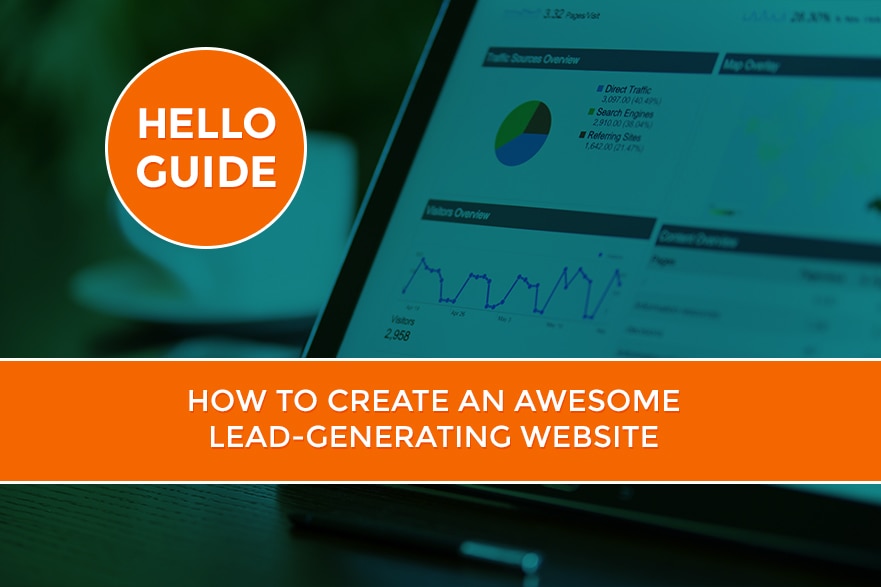Learn with Us
Hello Guide: How To Create An Awesome Lead-Generating Website

So, as you’ve probably noticed, we’ve posted a lot of listicles over the past year, and it’s time to change things up. This week, we’re going to begin with our first-ever Hello Guide, which will go over the main steps for creating a lead-generating website.
Your website is the best source for turning prospects into leads, and even returning customers. The most effective way to do this is to build your website around the idea of lead-generation. Here’s how you can accomplish this:
Step 1: Review Your Current Website
Start at the home page. What do you see before anything else, before you start scrolling—are there immediate calls-to-action? Is it a single-image slider with text? Maybe there’s contact info, or the main navigation menu.
Okay, now try to figure out what the main focus-point is. If your menu is the first thing, then it needs to be simple. So simple, really, that you can predict a prospect’s next move.
After going through the home page, check your other pages. Where do these pages guide your prospects? What can they expect, based on where they click? Think about this as you review.
Remember This Trick:
The more choices someone has, the less likely they are to click. This “choice paralysis” is really common, and it kills websites all the time. So minimize options, clear out clutter, and keep things simple.
Step 2: Build Your Funnels
Let’s say you sell apples on your website. In fact, you sell green apples, and red apples—and a typical customer for one is very different from the other. On your home page, you might put a split-call-to-action: Two buttons over the main image. One for green apples, and one for red apples.
So let’s say someone clicks the “red apples” button. Obviously, that means they’re interested in red apples.
But let’s also pretend that red apple customers are way more likely to simply get right down to it and place an order. The landing page from the button should be a bit more info on red apples, and then the option to add those apples to a cart.
Now, let’s say your green apple customers are a bit more cautious. They rarely buy right away, and like to view a bit more information first. By clicking the “green apples” button, your prospects should see more info, like a blog post, followed by info that helps build trust and proof.
Remember This Trick:
Learn your audience. Seriously, spend a lot of time learning who you’re targeting, and how you’ll reach them. One more thing—your web audience and your real-world audience aren’t going to be exactly the same people, or act the same way.
SEE MORE: [Infographic] Building Your Digital Audience: 5 Things Most People Forget
Step 3: Choose Your Lead-Generation Tools
This is where you get your pick of the litter, since there are several key ways to capture leads. Let’s cover some of the best tools for your business:
- Information Forms – Captures information that prospects voluntarily submit.
- Gated Content – Exchanges content (like an e-book) for information.
- Chat Bubbles – Offers extra assistance, and can help nurture leads.
- Pop-up Forms – Uses animation to attract interest to information forms.
There are other tools for off-site lead generation, but for the main part, try to keep things simple. It’s also essential to put effort into your content, and to make sure you’re reaching the right audiences—especially online.
Remember This Trick:
If you’re thinking of using pop-up forms, make sure you’re not using full-page interstitials, or Google’s going to penalize your website.
Step 4: Establish Trust and Provide Proof
The best way to make your website (and brand) seem more legitimate is to provide validity of some sort. Depending on your industry, this can be done in a number of ways:
- Using numbers and stats — “Millions of apples sold”, “30 years of Experience”.
- Mentioning when news agencies writing about your brand.
- Mentioning when celebrities, athletes, or notable people use your product.
- Including testimonials from customers.
- Including logos from companies you’ve worked with.
Take note that these elements of trust don’t necessarily speak to quality, so it helps to back them up, too:
- Money-back Guarantee
- Limited Warranty
- Reviews or Rating Section
There are different approaches for this, and you can always combine ideas to get different results.
Remember This Trick:
Including trust-building content is important, but the placement of this content could be even more crucial to the success of your website. Make sure not to bury it on a bottom-funnel page. Also remember that your proof is to prove how awesome you are, so be awesome, and then you won’t struggle to back it up!
Step 5: Create a Thoughtful, Elegant User Experience
Now that you’ve created your funnels and selected your tools, you need to think about the layout of your website. This layout needs to factor in text, images, and calls-to-action.
Since there’s no concrete way of knowing what will work immediately, it’s best to test out a few different layout options. Try different colours, placements, words, or images to get people interested.
Testing the layout may also include moving around your menu, social media buttons, contact info, and anything other key elements on your page.
Remember This Trick:
There are some great tools for discovering what’s working on your website, like HotJar.


